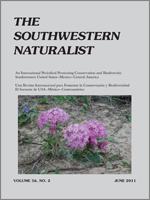We describe the migratory pattern of black terns (Chlidonias niger) in the Ojo de Liebre-Guerrero Negro coastal-lagoon complex and Guerrero Negro saltworks on the Pacific coast of Baja California Sur, Mexico. Most black terns (97% of total) were seen July–October, with 6,700 birds being the highest count per month (September). During spring, this species was observed only in April (220 individuals). We recorded 90% of black terns in the southeastern portion of Ojo de Liebre Lagoon, where they were in artificial (saltworks) and natural habitats (marsh and sandy shallows). In late summer (July–August), 94% were in the lagoon, by contrast, in autumn we recorded 96% in saltworks. Overall, black terns are a common transient in Guerrero Negro during summer and autumn and uncommon during spring. Black terns use these artificial and natural habitats as stopover areas during migration.
How to translate text using browser tools
1 June 2011
Migratory Patterns of the Black Tern (Chlidonias niger) at the Ojo de Liebre Wetland Complex, Baja California Sur, Mexico
Roberto Carmona,
Nallely Arce,
Víctor Ayala-Pérez,
Gustavo D. Danemann
ACCESS THE FULL ARTICLE

The Southwestern Naturalist
Vol. 56 • No. 2
June 2011
Vol. 56 • No. 2
June 2011




